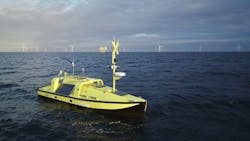Offshore staff
DENMARK — Ørsted says it has designed and developed the first uncrewed surface vessel (USV) in the industry for offshore metocean measurement campaigns. The measurement data will help lower uncertainties in the expected annual energy production for new offshore wind farms.
Ørsted, who has patented the USV concept, sees enormous potential in the technology and has initiated a serial production based on the successful prototype USV, which is named Hugin USV. It is designed for continuous operation in the harshest offshore conditions for a year at a time. The USV has a built-in navigation system, which enables it to transit from shore at various degrees of autonomy, and it can be controlled both in line-of-sight or from a beyond-line-of-sight remote control center.
USV's capabilities
The USV is designed as a generic sensor platform and can collect large amounts of data on, among other things, the wind conditions, the state of the seabed, and biological and ecological measurements, all dependent on the sensor instrumentation chosen for a given operation. The broad range of measurements collected by the USV is essential for Ørsted’s early-phase development activities prior to the construction of new wind farms.
The USV concept was invented by Ørsted employees and has been patented. The design, development, construction and testing of the prototype USV was conducted as part of Ørsted’s innovation program in collaboration with selected industry partners. The prototype USV is constructed by the Danish shipbuilder Tuco Marine Group, and the USV control system is delivered by Maritime Robotics.
Frederik Søndergaard Hansen, program manager and co-inventor of the USV concept, said, "What's so special about our USV concept is that it can bring our measurement equipment to and from our offshore sites without the need for large, specialized support vessels, and, while on site, it can operate autonomously for extended periods of time, measuring large amounts of data that can be sent onshore and processed in real time. The USV concept enables Ørsted to obtain a consistently high data availability, which is essential for achieving the highest possible certainty regarding the annual energy production for new offshore wind farms."
The Ørsted USV was also designed to improve safety by removing the risk for offshore technicians, reducing the overall carbon emissions significantly and increasing the operational window as it can operate safely in high sea state conditions.
Testing
The prototype vessel, Hugin USV, has been tested in Danish and Norwegian waters and has been operational during hurricane conditions, where it experienced waves up to 9 m in the North Sea. Hugin USV has also achieved type validation as a floating LiDAR system by DNV, enabling it to be used for commercial operations related to wind farm development.
In addition, Ørsted has started a serial production of a new class of USVs, which incorporates the learnings from the prototype and broadens the operational capabilities to include deepwater operations for future floating wind farms. The USVs in the new class are constructed in Denmark by Tuco Marine Group, and the control systems are delivered by Maritime Robotics. The expectation is to produce five new USVs by year-end 2023.
06.23.2023




